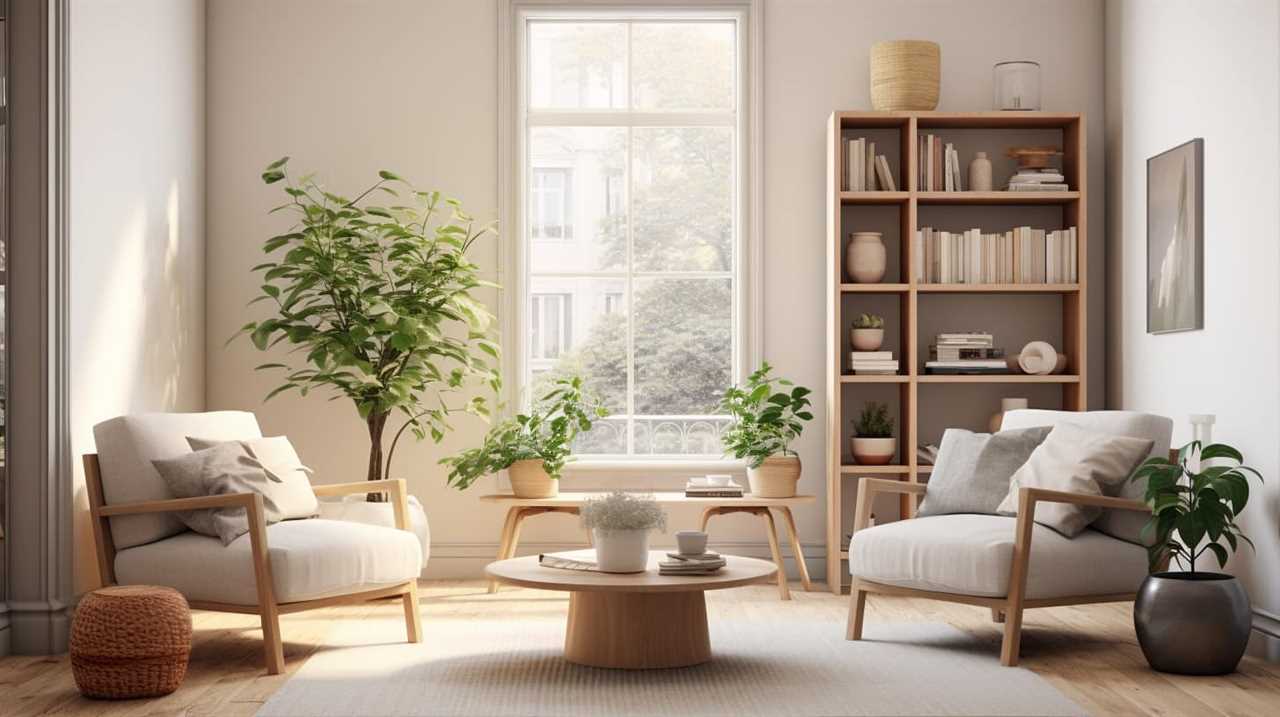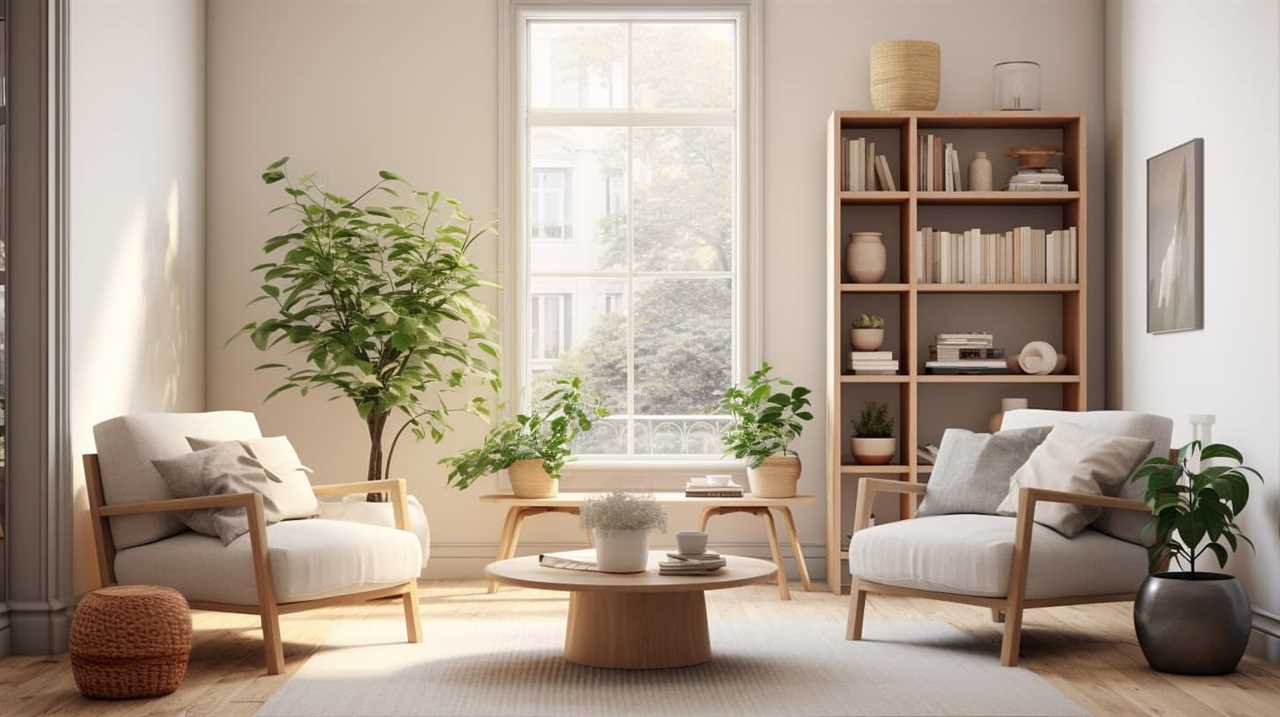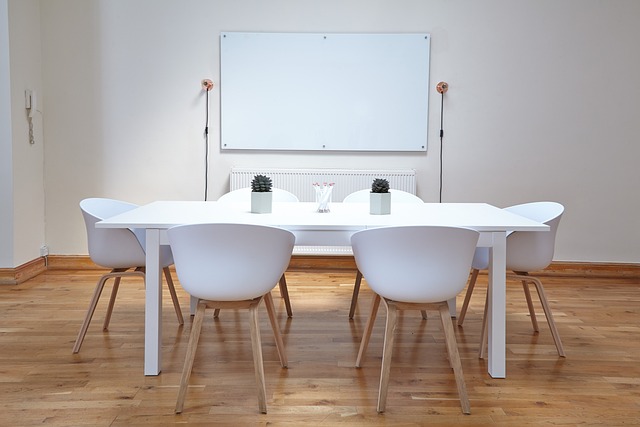As individuals striving for professional growth and fulfillment, we frequently feel inundated by the constant requests and distractions that accompany modern workspaces.
But what if I told you that embarking on a minimalist living journey can have a profound impact on our careers?
Like a gentle breeze that clears the path ahead, embracing minimalism can bring clarity, focus, and a renewed sense of purpose to our work, allowing us to serve others with even greater dedication and effectiveness.
Key Takeaways
- Minimalist living can help achieve work-life balance and create a fulfilling career.
- A decluttered and organized workspace promotes focus, efficiency, and creativity.
- Prioritization and streamlining lead to increased productivity and faster task completion.
- Simplifying communication and digital practices saves time, improves clarity, and prevents information overload.
The Correlation Between Minimalist Living and Work-Life Balance
In our professional lives, the correlation between minimalist living and work-life balance is evident. Achieving work-life integration is a constant struggle for many of us, and embracing a minimalist mindset can help us find the harmony we seek. By simplifying our lives and focusing on what truly matters, we can create a fulfilling career that aligns with our values and priorities.

Minimalist career planning involves identifying our passions and goals, and making intentional choices that support our work-life balance. It means letting go of excess commitments and distractions, and prioritizing our well-being. By embracing a minimalist lifestyle, we can create a space for ourselves where work and personal life seamlessly coexist, allowing us to thrive in both areas.
Now, let’s explore how a decluttered workspace can further boost our productivity.
The Productivity Boost of a Decluttered Workspace
We can experience a significant productivity boost when we clear out the clutter and organize our workspace. A decluttered workspace is essential for creating a minimalist work environment that promotes focus, efficiency, and creativity. Here are three reasons why a decluttered workspace can lead to increased productivity:
-
Improved focus: A clean and organized workspace eliminates distractions and allows us to concentrate on the task at hand. Without the clutter, our minds are free to focus on the work that needs to be done, leading to increased productivity.

-
Increased efficiency: When our workspace is decluttered, we spend less time searching for things and more time actually working. Everything has its place, making it easier to find what we need and complete tasks more efficiently.
-
Enhanced creativity: A minimalist work environment stimulates creativity by providing a clear and open space for our thoughts to flow. Without the visual distractions of clutter, our minds are free to generate new ideas and solutions.
The Benefits of Limiting Professional Belongings
When we limit our professional belongings, we can experience a range of benefits that positively impact our work lives.
Firstly, by reducing the number of items in our workspace, we can increase our focus and productivity. With fewer distractions, we can devote more time and energy to the tasks at hand.

Additionally, by streamlining our work processes and eliminating unnecessary items, we can create a more efficient workflow, saving time and effort.
Lastly, having a clean and organized workspace can enhance our professional image, making a positive impression on clients, colleagues, and superiors.
Increased Focus and Productivity
By limiting our professional belongings, we can experience increased focus and productivity. When we declutter our workspaces and minimize distractions, we create an environment that promotes concentration and allows us to fully immerse ourselves in our tasks. This increased concentration leads to improved time management, as we’re able to prioritize our work and eliminate unnecessary time-wasting activities.
Here are three ways that limiting our professional belongings can boost our focus and productivity:

-
Reduced visual clutter: A clutter-free workspace allows us to direct our attention solely to the task at hand, without the distraction of unnecessary items.
-
Enhanced mental clarity: Removing physical clutter from our work environment can also lead to mental clarity, enabling us to think more clearly and make better decisions.
-
Streamlined workflow: With fewer belongings, we can organize our workspace more efficiently, creating a smooth and seamless workflow that minimizes distractions and maximizes productivity.
Streamlined Work Processes
But, if we limit our professional belongings, we can streamline our work processes and experience several benefits. By streamlining processes and optimizing efficiency, we can create a more productive and stress-free work environment. When we declutter our workspace and eliminate unnecessary items, we can focus better and find what we need quickly. This leads to increased productivity and faster completion of tasks. Additionally, streamlining processes allows us to prioritize our work and allocate our time effectively. We can identify and eliminate bottlenecks, saving time and energy. Moreover, a streamlined work process allows for better collaboration and teamwork, as everyone is on the same page and can easily access the necessary resources. Let’s take a look at the table below to understand the benefits of streamlining our work processes:

| Benefits | Emotions Evoked |
|---|---|
| Increased productivity | Motivation |
| Reduced stress | Relief |
| Time savings | Efficiency |
| Improved collaboration | Teamwork |
As we can see, by limiting our professional belongings and streamlining our work processes, we can create an environment that fosters productivity, reduces stress, and promotes effective collaboration. Let’s embrace minimalism and optimize our professional lives.
Enhanced Professional Image
Our professional image can be greatly enhanced by limiting our professional belongings, resulting in a more polished and refined representation of ourselves. When we embrace a minimalist approach to our professional appearance, we unlock a multitude of benefits that can positively impact our careers. Consider the following:
-
Simplicity: By streamlining our wardrobe and accessories, we eliminate decision fatigue and save valuable time in the mornings. A minimalist fashion approach allows us to effortlessly put together stylish and appropriate outfits, projecting an image of professionalism and confidence.
-
Versatility: With a limited number of high-quality, versatile pieces, we can create a wide range of looks for any professional setting. A minimalist wardrobe ensures that we’re always prepared for meetings, presentations, and networking events.

-
Focus on essentials: By prioritizing quality over quantity, we can invest in timeless, well-made pieces that communicate our attention to detail and commitment to excellence. A minimalist approach encourages us to curate a wardrobe that reflects our unique style and professional identity.
Embracing a minimalist fashion philosophy not only enhances our professional image but also simplifies our lives, allowing us to focus on what truly matters – serving others and achieving our goals.
The Importance of Prioritizing Tasks in a Minimalist Approach
We find that prioritizing tasks is crucial in adopting a minimalist approach to maximize efficiency and productivity in our professional lives. By carefully selecting and organizing our tasks, we can effectively manage our time and focus on what truly matters.
Prioritization allows us to identify the most important and urgent tasks, ensuring that we allocate our time and energy accordingly. This not only helps us stay on track but also prevents us from feeling overwhelmed or scattered.

Quality Over Quantity: How It Applies to Your Career
By focusing on the quality of our work rather than the quantity, we can enhance our professional growth and success.
In today’s fast-paced and demanding work environment, it’s easy to get caught up in the mindset of doing more to achieve more. However, true workplace efficiency lies in our ability to deliver high-quality results that make a real impact.
Here are three reasons why prioritizing quality over quantity can benefit your career:
-
Reputation: Consistently producing high-quality work will earn you a reputation for excellence, which can lead to increased opportunities and recognition.

-
Personal growth: When we focus on quality, we challenge ourselves to improve our skills and knowledge, leading to personal and professional growth.
-
Long-term success: Quality work builds trust and loyalty with clients and colleagues, paving the way for long-term success in your career.
Simplifying Commitments: A Key to Professional Success
Simplifying commitments is a crucial step towards achieving professional success.
By focusing on what truly matters and eliminating unnecessary obligations, we create space for work-life balance and personal growth.

This intentional approach allows us to increase our focus and productivity, leading to better decision-making skills and ultimately, a more fulfilling and successful professional life.
Work-Life Balance Benefits
Sometimes, achieving a work-life balance can be a key factor in our professional success. It’s important to find ways to simplify our commitments and create harmony between our personal and professional lives. Here are three work-life balance strategies and minimalist living tips that can benefit our professional journey:
-
Prioritize: Identify your most important tasks and focus on those first. By setting clear priorities, you can allocate your time and energy effectively, ensuring that you accomplish what truly matters.
-
Establish boundaries: Learn to say no to unnecessary commitments and set boundaries between work and personal life. This will allow you to dedicate quality time to both aspects without feeling overwhelmed or burnt out.

-
Practice self-care: Take care of your physical, mental, and emotional well-being. Engage in activities that recharge you, such as exercise, meditation, or spending time with loved ones. By prioritizing self-care, you’ll have the energy and motivation to excel in your professional life.
By implementing these work-life balance strategies and embracing a minimalist mindset, we can create a fulfilling and successful professional life while also nurturing our personal well-being.
Transitioning into the next section, let’s explore how achieving a work-life balance can lead to increased focus and productivity.
Increased Focus and Productivity
To achieve increased focus and productivity in our professional lives, we must prioritize our commitments and establish clear boundaries.

By simplifying our commitments, we create space for increased creativity and improved time management. When we’ve fewer obligations pulling us in different directions, we can fully dedicate ourselves to the tasks at hand. This focused approach allows us to delve deeper into our work, generating new ideas and solutions.
By setting clear boundaries, we protect our time and energy from being drained by unnecessary distractions. This empowers us to stay on track and complete our tasks efficiently.
As we embrace a minimalist mindset, we free ourselves from the burden of excessive commitments, enabling us to tap into our full potential and achieve professional success.
Better Decision-Making Skills
By making fewer but more intentional commitments, we can enhance our decision-making skills and pave the way for greater professional success. Simplifying our commitments allows us to focus on what truly matters and make informed choices that align with our goals and values.

When we’ve fewer obligations pulling us in different directions, we can invest more time and energy into each decision, leading to improved problem-solving abilities. This clarity of mind allows us to see the bigger picture and consider all possible options before making a choice.
Additionally, simplifying commitments opens up space for increased creativity. When we aren’t overwhelmed by a multitude of obligations, our minds are free to explore new ideas and think outside the box, ultimately leading to innovative solutions and fresh perspectives.
Embracing minimalism in our professional lives can unlock our true potential and set us on a path to success.
- Fewer commitments, more focus
- Enhanced problem-solving skills
- Increased creativity and innovation
Practicing Digital Minimalism in the Workplace
We can enhance our productivity and reduce distractions by implementing digital minimalism practices in the workplace. Practicing mindfulness and adopting a digital detox can help us create a more focused and efficient work environment.

Mindfulness allows us to be fully present in the tasks at hand, enabling us to give our undivided attention and produce higher quality work. A digital detox, on the other hand, involves taking breaks from technology to recharge and refocus our minds. By disconnecting from constant notifications and distractions, we can regain control over our time and energy.
Implementing these practices not only benefits our professional lives but also promotes a healthier work-life balance. As we continue our minimalist journey, let’s now explore how identifying essential skills can help us connect to minimalism in a more meaningful way.
Identifying Essential Skills: Connecting to Minimalism
Sometimes, but, we can discover our essential skills by embracing minimalism in our professional lives. When we adopt a minimalist mindset, we’re able to focus on what truly matters and strip away the unnecessary distractions. This allows us to identify and cultivate the skills that are essential for our success.
Here are three key ways in which minimalism can help us uncover our essential skills:

-
Prioritization: By simplifying our work environment and decluttering our tasks, we can better prioritize what needs our attention. This helps us identify the skills that are most crucial for our professional growth.
-
Adaptability: Minimalism teaches us to be flexible and adaptable, which are essential skills in any professional setting. When we embrace simplicity and let go of attachments, we become more open to change and can easily adapt to new challenges.
-
Effective communication: Minimalism encourages us to be clear and concise in our communication. This skill is highly valuable in the workplace, as it enables us to convey our ideas and thoughts effectively, fostering better collaboration and understanding.
Streamlining Communication for Efficiency
When it comes to streamlining communication for efficiency, we can reap numerous benefits in our professional lives.

By delivering clearer messages, we can avoid misunderstandings and save time.
Eliminating unnecessary communication allows us to focus on what truly matters, increasing our productivity and ultimately achieving our goals faster.
Clearer Messages, Faster
Our team’s adoption of minimalist living principles has resulted in clearer messages and faster communication, streamlining efficiency in our professional interactions.
By decluttering our communication channels and focusing on essential information, we’ve eliminated the confusion and ambiguity that often arise from excessive emails and lengthy discussions. This newfound clarity allows us to convey our ideas and instructions more effectively, ensuring that everyone is on the same page and working towards common goals.

Additionally, by streamlining our communication processes, we’ve saved valuable time that can now be dedicated to more important tasks. With clearer messages and faster communication, we’re able to optimize our time management and accomplish more in our professional lives.
As we continue on our minimalist journey, we look forward to exploring further ways of eliminating unnecessary communication and maximizing our productivity.
Eliminating Unnecessary Communication
By cutting out unnecessary communication and streamlining our processes, we can increase efficiency and productivity in our professional lives. In today’s fast-paced world, we’re bombarded with constant messages, emails, and notifications that can easily distract us from our work. By reducing distractions and optimizing efficiency in our communication, we can create a focused and productive work environment.
One way to eliminate unnecessary communication is by setting clear expectations and guidelines for communication within our teams. Establishing communication protocols and channels can help to prevent information overload and ensure that messages are delivered in a timely and organized manner.

Additionally, it’s important to prioritize communication and only engage in conversations that are necessary for our work. This means learning to say no to meetings or discussions that don’t contribute to our goals or tasks.
Improved Productivity and Focus
To maximize our productivity and focus, we can streamline communication by establishing clear guidelines and utilizing efficient channels. By implementing these strategies, we can experience improved time management and increased creativity in our professional lives.
Here are three ways to streamline communication for enhanced productivity:
-
Embrace technology: Utilize tools such as project management software, instant messaging platforms, and video conferencing to facilitate quick and effective communication.

-
Set clear expectations: Establish guidelines for communication, including response times and preferred methods, to ensure everyone is on the same page and avoid unnecessary back-and-forth.
-
Foster a culture of open communication: Encourage team members to share ideas and collaborate freely, promoting creativity and innovation.
By streamlining communication, we can eliminate distractions and better focus on our tasks, leading to improved productivity and increased creativity.
Now, let’s explore how minimalist practices can help reduce job stress.

Reducing Job Stress Through Minimalist Practices
In our fast-paced society, we often find ourselves overwhelmed by job stress, but embarking on a minimalist living journey can help us reduce stress and find greater balance in our professional lives. By adopting minimalist practices, we can simplify our work environment and streamline our tasks, leading to increased job satisfaction and reduced burnout.
A minimalist approach encourages us to prioritize the essential tasks and eliminate unnecessary distractions. This allows us to focus our energy on meaningful work, leading to increased productivity and a sense of fulfillment.
To illustrate the benefits of minimalist practices in the workplace, let’s take a look at the following table:
| Minimalist Practice | Benefits |
|---|---|
| Decluttering | Increased focus |
| Time management | Reduced overwhelm |
| Digital organization | Enhanced efficiency |
By incorporating these practices into our professional lives, we can create a calm and organized work environment, leading to reduced stress and improved job satisfaction.

Transitioning into the subsequent section, let’s dive deeper into an in-depth analysis of how minimalism can transform the workplace and provide long-lasting benefits.
In-Depth Analysis: Long-Form Answers on Minimalism in the Workplace
Let’s explore the transformative effects of minimalism in the workplace through an in-depth analysis. When it comes to workplace organization, adopting minimalist practices can have a profound impact on your career growth. Here are three reasons why:
-
Increased focus: By decluttering your workspace and eliminating distractions, you can enhance your ability to concentrate on the tasks at hand. This heightened focus won’t only boost your productivity but also allow you to deliver high-quality work.
-
Enhanced efficiency: Minimalism promotes simplicity and efficiency. By streamlining your work processes and eliminating unnecessary steps, you can save time and energy. This newfound efficiency will enable you to take on more responsibilities and achieve greater success in your career.

-
Improved creativity: A clutter-free and organized workspace can stimulate your creativity. With a clear mind and a clean environment, you can think more creatively, generate innovative ideas, and find new solutions to challenges.
Embracing minimalism in the workplace can bring about positive changes that will propel your career forward. So start decluttering and simplifying today, and watch your professional life flourish.
Exploring the Impact of Minimalist Living on Different Career Aspects
With minimalist living, we can examine how it affects various aspects of our careers. One of the key areas impacted by minimalist living is corporate culture. By embracing minimalism, we can create a more focused and streamlined work environment. Clutter-free workspaces promote clarity of thought and enhance productivity. Minimalism also encourages a culture of efficiency and simplicity, which can positively influence the overall corporate culture.
Moreover, minimalist living can have a significant impact on career advancement. By adopting a minimalist mindset, we prioritize what truly matters and eliminate distractions. This allows us to focus on our goals, make informed decisions, and take proactive steps towards professional growth. Minimalism teaches us to be intentional with our time, energy, and resources, enabling us to achieve greater success in our careers.

Embracing a minimalist lifestyle can truly transform our professional lives for the better.
Frequently Asked Questions
How Can Minimalist Living Improve Work-Life Balance?
Improving work-life balance through minimalist living involves workplace organization and stress reduction. By decluttering our physical and mental spaces, we create a harmonious environment that allows us to focus on what truly matters, leading to increased productivity and overall professional success.
What Are the Specific Productivity Benefits of Having a Decluttered Workspace?
When we declutter our workspace, we experience increased focus and improved creativity. By eliminating distractions and creating an organized environment, we can maximize productivity and achieve our professional goals with ease.
How Does Limiting Professional Belongings Benefit My Career?
Limiting distractions and increasing focus are key to professional success. By limiting our professional belongings, we create a clutter-free environment that allows us to be more productive and efficient in our work, ultimately benefiting our career.

Why Is Prioritizing Tasks Important in a Minimalist Approach to Work?
Prioritizing tasks is crucial in a minimalist approach to work. It allows us to focus on what truly matters, maximize productivity, and achieve our goals. Effective time management strategies ensure that we make the most of our limited resources.
How Does the Principle of Quality Over Quantity Apply to My Career?
In our professional lives, the principle of quality over quantity can have a profound impact. By embracing a minimalist work environment and prioritizing efficiency, we can achieve greater focus, productivity, and ultimately, serve others more effectively.
Conclusion
In conclusion, embarking on a minimalist living journey can have a profound impact on our professional lives. It allows us to achieve a better work-life balance, boost productivity with a decluttered workspace, and prioritize tasks effectively.
By embracing quality over quantity and streamlining communication, we can reduce job stress and enhance efficiency. Just like a clean canvas ready for an artist’s masterpiece, adopting minimalist practices in our careers can create a space for growth and success.

I’m Theodore, and I love tiny houses. In fact, I’m the author of Tiny House 43, a book about tiny houses that are also tree houses. I think they’re magical places where imaginations can run wild and adventures are just waiting to happen.
While tree houses are often associated with childhood, they can be the perfect adult retreat. They offer a cozy space to relax and unwind, surrounded by nature. And since they’re typically built on stilts or raised platforms, they offer stunning views that traditional homes simply can’t match.
If you’re looking for a unique and romantic getaway, a tree house tiny house might just be the perfect option.
















